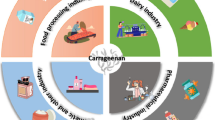Abstract
Objective
To investigate the biocatalytic potential of Colletotrichum acutatum and Colletotrichum nymphaeae for monoterpene biotransformation.
Results
C. acutatum and C. nymphaeae used limonene, α-pinene, β-pinene, farnesene, citronellol, linalool, geraniol, perillyl alcohol, and carveol as sole carbon and energy sources. Both species biotransformed limonene and linalool, accumulating limonene-1,2-diol and linalool oxides, respectively. α-Pinene was only biotransformed by C. nymphaeae producing campholenic aldehyde, pinanone and verbenone. The biotransformation of limonene by C. nymphaeae yielded 3.34–4.01 g limonene-1,2-diol l−1, depending on the substrate (R-(+)-limonene, S-(−)-limonene or citrus terpene (an agro-industrial by-product). This is among the highest concentrations already reported for this product.
Conclusions
This is the first report on the biotransformation of these terpenes by Colletotrichum spp. and the biotransformation of limonene to limonene-1,2-diol possibly involves enzymes similar to those found in Grosmannia clavigera.


Similar content being viewed by others
References
Bock G, Benda I, Schreier P (1986) Biotransformation of linalool by Botrytis cinerea. J Food Sci 51:659–662
Chang HC, Oriel P (1994) Bioproduction of perillyl alcohol and related monoterpenes by isolates of Bacillus stearothermophilus. J Food Sci 59:660–662
Damm U, Baroncelli R, Cai L, Kubo Y, O’Connell R, Weir B, Yoshino K, Cannon PF (2010) Colletotrichum: species, ecology and interactions. IMA Fungus 1:161–165
de Oliveira Felipe L, de Oliveira AM, Bicas JL (2017) Bioaromas—perspectives for sustainable development. Trends Food Sci Technol 62:141–153
Demyttenaere JCR, Willemen HM (1998) Biotransformation of linalool to furanoid and pyranoid linalool oxides by Aspergillus niger. Phytochemistry 47:1029–1036
Kajihara KK, Amaral JA, Toia RF (2000) Stability and detection of α-pinene oxide in aqueous culture medium. Environ Toxicol Chem 19:2235–2238
Larkin MA, Blackshields G, Brown NP, Chenna R et al (2007) Clustal W and Clustal X version 2.0. Bioinformatics 23:2947–2948
Maróstica MR Jr, Pastore GM (2007) Production of R-(+)-α-terpineol by the biotransformation of limonene from orange essential oil, using cassava waste water as medium. Food Chem 101:345–350
Mirata MA, Wüst M, Mosandl A, Schrader J (2008) Fungal biotransformation of (±)-linalool. J Agric Food Chem 56:3287–3296
Molina G, Bution ML, Bicas JL, Dolder MAH, Pastore GM (2015) Comparative study of the bioconversion process using R-(+)- and S-(−)-limonene as substrates for Fusarium oxysporum 152B. Food Chem 174:606–613
Moriya Y, Itoh M, Okuda S, Yoshizawa AC, Kanehisa M (2007) KAAS: an automatic genome annotation and pathway reconstruction server. Nucl Acid Res 35:W182–W185
Stanke M, Diekhans M, Baertsch R, Haussler D (2008) Using native and syntenically mapped cDNA alignments to improve de novo gene finding. Bioinformatics 24:637–644
van der Werf MJ, Swarts HJ, de Bont JA (1999) Rhodococcus erythropolis DCL14 contains a novel degradation pathway for limonene. Appl Environ Microbiol 65:2092–2102
Velasco-Bucheli R, Mesa A, Gil J, García C, Durango D (2015) Transformation of trans-anethole using the plant pathogenic fungus Colletotrichum acutatum as biocatalyst. Rev Mex Ing Quim 14:653–666
Wang Y, Lim L, Madilao L, Lah L, Bohlmann J, Breuil C (2014) Gene discovery for enzymes involved in limonene modification or utilization by the mountain pine beetle-associated pathogen Grosmannia clavigera. Appl Environ Microbiol 80:4566–4576
Waterhouse AM, Procter JB, Martin DMA, Clamp M, Barton GJ (2009) Jalview version 2: a multiple sequence alignment and analysis workbench. Bioinformatics 25:1189–1191
Acknowledgements
The authors acknowledge the Citriculture Defense Fund and Brazilian Collection of Environmental and Industrial Microorganisms for the stains and Espaço da Escrita – Coordenadoria Geral da Universidade (UNICAMP) for the language services provided.
Supporting information
Supplementary information—Additional methods. Biomass growth and extraction, identification, and quantification of biotransformation products.
Supplementary Table 1—BLASTp output of reference enzymes from Grosmannia clavigera against Colletotrichum acutatum and Colletotrichum nymphaeae protein sets.
Supplementary Table 2—Colletotrichum nymphaeae enzymes - KAAS annotation.
Supplementary Table 3—Colletotrichum acutatum enzymes - KAAS annotation.
Supplementary Fig. 1—Sequence alignment of the epoxyde hydrolase candidate proteins from C. acutatum and C. nymphaeae (KXH64709.1) along with the previously described epoxide hydrolase from G. clavigera (F0X7A7).
Supplementary Fig. 2—Sequence alignment of the FAD-binding monooxygenase candidate proteins from C. acutatum and C. nymphaeae (KXH59233.1) along with the previously described FAD-binding monooxygenase from G. clavigera (F0X7A8).
Funding
This study was funded by the National Counsel of Technological and Scientific Development (CNPq) (Grant Numbers 473981/2012-2 and 400411/2016-4); São Paulo Research Foundation (FAPESP) (Grant Number 2016/21619-7) and Coordination for the Improvement of Higher Education Personnel (CAPES) (scholarship, A. Sales).
Author information
Authors and Affiliations
Corresponding author
Ethics declarations
Conflict of interest
The authors declare that they have no conflict of interest.
Electronic supplementary material
Below is the link to the electronic supplementary material.
Rights and permissions
About this article
Cite this article
Sales, A., Afonso, L.F., Americo, J.A. et al. Monoterpene biotransformation by Colletotrichum species. Biotechnol Lett 40, 561–567 (2018). https://doi.org/10.1007/s10529-017-2503-2
Received:
Accepted:
Published:
Issue Date:
DOI: https://doi.org/10.1007/s10529-017-2503-2




